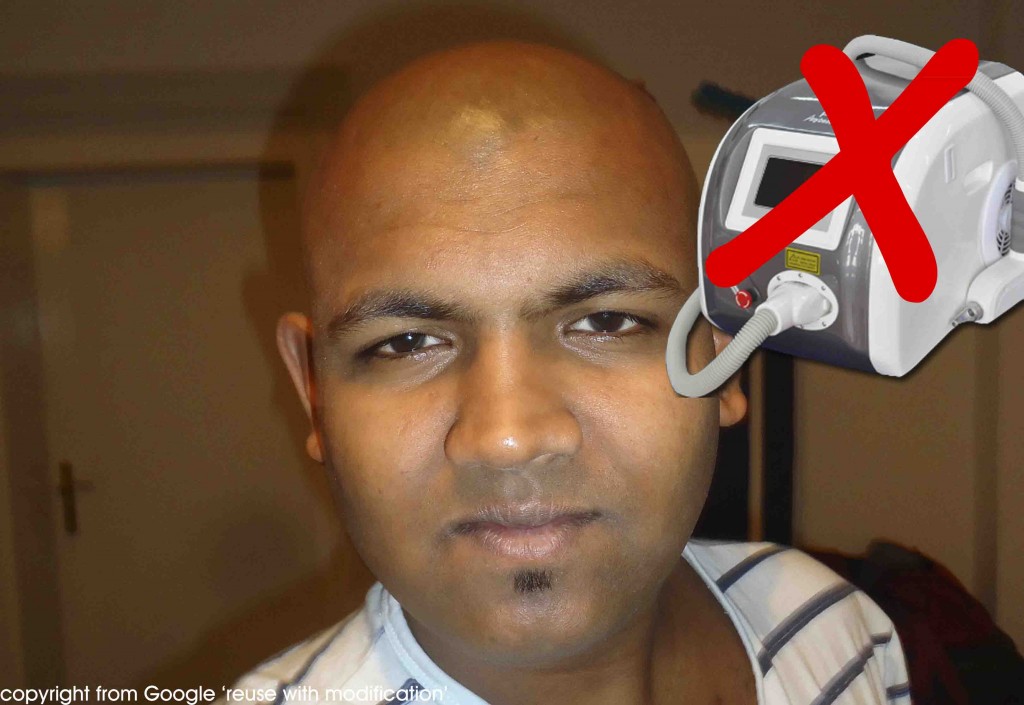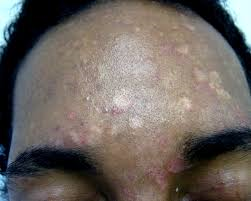Should I have scalp laser tattoo removal if I have black or Asian Skin?
If you have been doing your research in relation to scalp micropigmentation (SMP), Scalp tattooing and Tricopigmentation* then you have possibly seen treatment being carried out on both black and dark Asian skin types. All these three forms of treatment can initially have some very impressive before and after photos, however what we see rarely are the after photos 2-5 years down the line. There’s often very good reason for this, as explained before with regards to Scalp micropigmentation and scalp tattooing, over time the vast majority of permanent ink pigments inserted into the dermis layer of the skin start to blur and spread slightly. The easiest way to visualise this is to consider a normal tattoo which has recently been applied to an arm for example, its nice and crisp with sharp defined edges, however similar tattoos that are several years old will be slightly blurred with less defined edges and the colour is no longer sharp and vivid. So now consider the same happening to your scalp tattoo, those hair follicle are no long crisp and sharp, may have changed colour slightly or increased in size giving an unrealistic noticeable appearance. However the scalp micropigmentation and scalp tattooing say they have the answer for this problem, simple laser tattoo removal?
So in future your scalp micropigmentation or scalp tattoo is not how you want it to appear, you have black or dark Asian skin and you return back to the studio you initially had the treatment at to have scalp laser tattoo removal and new fresh crisp pigment re-applied. All sounds great, a nice easy way to keep your scalp looking perfectly natural for many years to come. The issue is the vast majority of scalp micropigmentation artist in the UK market today have very little if any experience with regards to scalp laser tattoo removal. A fully trained and experienced laser tattoo removal technician will tell you that laser tattoo removal may NOT be possible on dark and Asian skin types. The skin types that typically fall within skin types 5 & 6 on the Fitzpatrick scale ( you can test which Fitzpatrick skin type you are here ) are recommended not be treated with laser tattoo removal. To our knowledge there are currently no insurance companies in the country that will insure a laser technician to treat a client with such skin types. This is due to the very real risk of the laser ‘zapping’ the dark melanin under the skin, consequently killing the melanin and causing hypopigmentation . As the melanin has been killed it leaves white areas of skin, which often regrettably become permanent.
If the client is not quite as dark and on the Fitzpatrick scale and fall into level 4 then some laser tattoo removal clinics may carry out scalp laser tattoo removal on a client . Dependant on the laser used (especially Ruby laser) the risk of hypopigmentation is still reasonably high and more often than not the technician will ask the client to sign a waiver indemnifying the clinic from blame should hypopigmentation occur. You should be mindful that in some instances although hypopigmentation has occurred, we have observed that within client which fall within the Fitzpatrick level 4, that sometimes the melanin will recover over the course of several months (3-9 months), however unfortunately there are no absolute guarantees of such recovery so caution should be taken.
Picture above is obviously an example only of hypopigmentation and not a result of scalp laser tattoo removal (naturally no one wants to publish these ).
So what’s our recommendation? Well if you’re considering Scalp micropigmentation or scalp tattooing and you believe you may fall within a Fitzpatrick scale 4-6 we firstly recommend that you carry out a Fitzpatrick test (there are plenty of free options available online) to confirm this. We feel we should point out that despite obvious skin tone, sometimes regardless of colour, due to hypersensitivity of some peoples melanin they may still fall into Fitzpatrick levels 4-6 (this has been seen in many white Caucasians also) and subsequently all good laser clinics should test ALL their clients on the Fitzpatrick scale prior to laser removal taking place.
If you do fall within a level 4-6 then you should be asking yourself, will I be happy with my scalp micropigmentation or scalp tattoo for the rest of my life, will that hair line of a 30 year old look right when I’m 50 or 60, will it still look natural in years to come, will the pigments bleed and blur, can I trust my technician to put my concerns 1st before their profits? If you have any of these doubts then we simply suggest, due to the very real risks of hypopigmentation for future laser removal, that you look at other viable hair follicle replication or transplant procedures as scalp micropigmentation or scalp tattooing may not be for you?
Early in this article we mentioned Tricopigmentation* as an option in relation to scalp micropigmentation. With Tricopigmentation* you achieve very similar results as will scalp tattooing etc, yet as the pigments only enters the epidermis layer of the skin then in years to come the pigment eventually exfoliates from within the skin allowing for fresh new pigment to be inserted to give that crisp new natural hair follicle look once again or give a new realistic hair line to suite the ageing process of the client. As the pigments within tricopigmentation* do not go into the dermis layer of the skin as with scalp micropigmentation then they do not require scalp laser tattoo removal. The latter meaning Tricopigmentation* (sometimes called pigmentalia) is a first choice consideration for all black and Asian skin types when it comes to considering hair follicle micropigmentation.
*Results may vary from person to person









 *
*